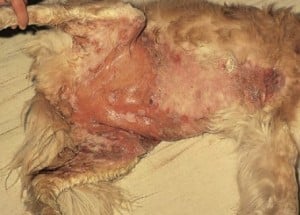It is inevitable that you will encounter a methicillin-resistant staphylococcus (MRSA) case in practice. It is also likely that you will have a client with MRSA and be asked about transmission of this type of bacteria to their pet. Because these infections are becoming more common, knowledge of this subject is important to the health of your patients.

DIAGNOSIS OF RESISTANT INFECTIONS
If the doctor has a patient with pyoderma that is responding poorly to treatment, he/she will likely want to perform a culture of the affected area, which you as a veterinary technician may be asked to perform.
How do you perform a culture like this since there are so many bacteria that may normally and typically be found on the skin? The best way is to use a sterile culture swab and take a sample of fluid inside an intact pustule, wet a sterile swab with sterile saline and rub under some scales, crusts, or around the rim of an epidermal collarette, you can obtain a punch biopsy if the tissue is severe and deep pyoderma is present, or otic exudates if the infection is in the ear. If the culture is positive for MRSA or similar bacteria, pets may require a prolonged course of antibiotics or topical medications and shampoos.
IS THIS BACTERIA ZOONOTIC?
Yes, MRSA is zoonotic and you should inform the owner as such. However, not to create panic, let them know that transmission is still rare and inform them on what they can do to minimize chance of transmission (handwashing, avoiding direct contact especially to open wounds, frequently wash bedding, no licking or kissing on the face, good hygiene, etc.) It is more of a concern in humans that are immunocompromised. That being said, veterinarians and veterinary technicians should never make recommendations for preventing or diagnosing this disease in humans and thus always recommend that they talk to their physician if they are having specific concerns about their own health issues.
PREVENTING THE SPREAD OF MRSA
If you know or suspect a dog has MRSA, keep them isolated from other pet patients. Take them to a room immediately on arrival and don’t allow them to sit in the waiting room where there are other patrons. Use gloves and gowns when handling these pets. Hand washing, as always, is one of the most important prevention measures. Properly clean your stethoscope and clothing when exposed and use thermometer covers or dispose of thermometers used on that patient. MRSA can survive for months on fomites/inanimate objects. Just as you would with a parvo case, disinfect the rooms, tables, floors, sinks, light switches, etc. in areas the patient has been.


